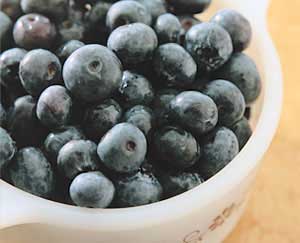Search Healthnotes

Related Topics
-
Recipes with Blueberries
-
Can Vitamin D Deflect Diabetes?
-
Overlooked Vitamin Offers Diabetes Protection
- By Suzanne Dixon, MPH, MS, RD
Eat Purple, Red, and Blue to Manage Diabetes Risk
Diet and nutrition play an important role in type 2 diabetes risk, but less is known about how phytonutrients—non-vitamin, non-mineral substances in plants—may protect against the disease. A new piece of the puzzle has fallen into place, with flavonoids emerging as one possible way to reduce type 2 diabetes risk. Flavonoids are found in a wide range of brightly colored fruits and vegetables, as well as dark chocolate, nuts, red wine, soy products, and tea.
Blueberries, blackberries, strawberries, and red cabbage are examples of flavonoid-rich foods
Factoring in flavonoids
Flavonoids are a group of nutrients that give many plant foods their bright purple, red, and blue colors. Blueberries, blackberries, strawberries, and red cabbage are examples of flavonoid-rich foods.
To study how these nutrients affect type 2 diabetes risk, researchers collected diet and lifestyle information approximately every four years beginning in 1980, and continuing through 2003, from more than 200,000 adult men and women. They looked at five sub-groups of flavonoids:
- flavonols,
- flavones,
- flavanones,
- flavan-3-ols, and
- anthocyanins.
Other factors that can affect diabetes risk were assessed and accounted for, including age, body weight, ethnicity, physical activity, multivitamin use, smoking, alcohol use, family history of diabetes, menopausal status, and hormone use in females. Dietary patterns were also reviewed, including caloric intake and the amounts and types of certain foods in participants' diets, including dietary fats, red meat, fish, high-calorie soda and punch, and coffee.
Anthocyanins, the favorite flavonoid
After analyzing data collected over nearly a quarter century, the researchers found:
- People who ate the most anthocyanins were 15% less likely to develop type 2 diabetes compared with people who ate fewer of these nutrients.
- People who ate the most blueberries, a food particularly rich in anthocyanins, were 23% less likely to develop type 2 diabetes compared with people who did not regularly eat blueberries.
- People who ate the most apples and pears, both anthocyanin-packed foods, were 23% less likely to develop type 2 diabetes compared with people who did not eat many apples or pears.
Finding flavonoid-rich food choices
While this study is observational and cannot prove a cause-and-effect relationship, it agrees with previous research suggesting anthocyanins and foods that contain these flavonoids may protect against chronic disease. Our tips will help you work more healthy anthocyanin-rich foods into your daily diet, as well as other flavonoids that have been found to enhance health in other studies.
- Begin with breakfast. The first meal of the day is ideal for working in anthocyanins. Add fresh or frozen blueberries or raspberries to your oatmeal or cereal. Or try a fruit smoothie by blending together 1/2 cup Greek yogurt; 1 cup soy, rice, almond, or skim milk; and 1 cup fresh or frozen mixed berries.
- Snack smartly. Snacks are a great place for squeezing in more anthocyanins. A small handful of almonds or walnuts mixed with 1/3 cup dried blueberries makes for a tasty mid-afternoon break.
- Involve the kids. During berry season, gather up the kids and head out for a couple of hours of berry picking at a local, “u-pick” farm. Kids who are more involved in food preparation—and in this case food gathering—are more likely to enjoy the healthy fare featuring that food.
- Explore ethnic foods. Ethnic foods are a great way to get your flavonoids. Purple cabbage and onions appear in many Asian dishes, and black beans, a staple in Mexican food, offer a nice array of flavonoids too.
(Am J Clin Nutr 2012;95:925–33)











